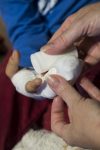
One health care field is especially in demand and at the same time, it is attractive to young generations – medical assisting.
This high demand is due to the knowledge and skills that medical assistants possess which is extremely useful and beneficial for any health care facility.
These professionals job is to provide patient care, assist doctors with medical procedures, and make sure the healthcare office runs professionally.
When it comes to common types of medical assisting careers, we have to mention that there are two of them available: clinical and administrative.
Administrative medical assistants are in charge of clerical duties and sometimes they assist with the general activities of the facility, while clinical medical assistants are supposed to work directly with patients, doctors, and other health care staff as well as assist with procedures.
Page Navigation
Frequent Clinical Medical Assistant Job Duties
If we take into consideration one working day in the life of a clinical medical assistant, we have to say that their work usually takes place in the back office of a medical facility as they are responsible for assisting doctors, nurses, other health care staff, and patients.
You can find them working directly with patients being that they are educated and trained to provide hands-on care and testing which has to be done under a physician’s supervision.
Their job duties involve taking a patient’s medical history, taking and recording vital signs, specimen collection, and testing, administering injections, and many other patient examinations.
Places Where Clinical Medical Assistants Can Find Employment
Just like any other healthcare professional, clinical medical assistants can look for employment in a range of settings.
You can find them working in a doctor’s office or medical practice, the two most frequent locations.
However, clinical medical assistants are also employed in other common places such as hospitals, rehabilitation centers, urgent care centers, research facilities, and therapy centers.
Clinical Medical Assistant Education Requirements
What some people would consider great is the fact that the United States has no formal education requirements for medical assisting.
Still, to be well equipped with the necessary knowledge and gain an advantage over other candidates for employment, you should think about enrolling in one of the numerous training programs available across the country.
Future medical assistants will get the needed knowledge through classroom education, while the skills will be learned through the hands-on laboratory training parts.
These programs are offered by community colleges, technical schools, vocational training centers, universities, and some employers.
How to Become a Clinical Medical Assistant?
The most frequent path that interested people take to become clinical medical assistants is completing a medical assisting training program.
There are clinical medical assistants who make a decision to specialize in a specific field in the health care industry, such as ophthalmology, optometry, or podiatry.
They will have to take additional training related directly to the specialty.
If training in computers and electronic medical records is not included in the medical assisting program curriculum, it has to be finished as additional training so as to be allowed to start working as a clinical medical assistant.
Once all these kinds of training are completed, the clinical medical assistant becomes eligible for employment.








